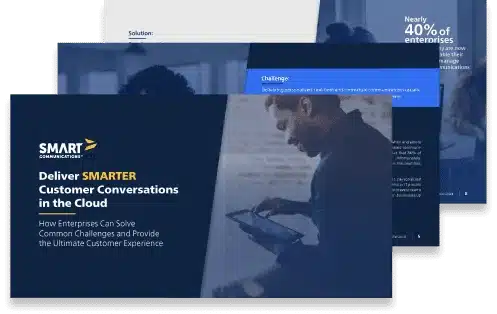Modernizing P&C Insurance Communications: Addressing the Needs of The Business to Elevate Customer Engagement
By Eileen Potter, VP of Insurance Marketing, Smart Communications
Insurers are faced with a growing list of challenges. Technology-driven disruptions. Evolving consumer expectations. Intense cost and competitive pressures. Regulatory change. Environmental sustainability. Lingering economic uncertainty.-The pressure on insurers is real as the pace of change only continues to accelerate.
But it is interesting to note that on some level, the insurance industry has not changed. And by that, I mean the fundamental operational areas of insurance – which are policy administration and claims management, and the functions fall under those – are the same, quoting, underwriting, billing, FNOL, etc. But traditional insurance business models are being challenged by new thinking, new competitors, and new ways of working. -
Earlier this year, Smart Communications, in collaboration with Guidewire and AWS, hosted a webinar titled "Get Future-Ready with Modern Digital Insurance Communications." I was fortunate enough to moderate a panel of industry experts for a conversation focused on the transformative potential of digital communications within the insurance sector, and how the powerful combination of our technologies accelerates time to value, boosts agility and efficiency, and ultimately empowers insurers to deliver superior customer experiences at every moment in the policy and claims lifecycles.
Keeping Pace with Customer Expectations
As customer expectations continue to rise, insurers must find ways to enhance policyholder communications and elevate the overall customer experience, and one of those ways is to change the way that communications are managed in their organization.
Traditionally, policyholder communications have been centralized, with limited input or control from individual business units. This approach often results in generic messages that fail to resonate with customers on a personal level. However, by decentralizing communication management and placing it in the hands of business units, insurance companies can tailor their messages to better meet the unique needs and preferences of different customer segments, while also addressing the specific needs of each area of the business.
Some examples:
|
Business Unit |
Need |
|
Information Technology- |
Focus on core functions, Standards based, Secure and Resilient |
|
Legal & Compliance-- |
Protection from risk, Control of content- |
|
Marketing & Sales- |
Brand consistency, Customer experience- |
|
Customer Service- |
Flexibility, Speed, Accuracy- |
|
Lines of Business (Policy, Claims, Billing)- |
Ability to adapt, New products, Acquisitions |
Empowering business units to contribute to policyholder communications not only allows for greater customization but also fosters a sense of ownership and accountability. When teams have input into crafting and delivering messages, they are more invested in ensuring the content is relevant, timely, and effective. This sense of ownership can lead to a higher quality of communication that resonates with policyholders and strengthens their relationship with the insurance company.-
Taking a Strategic Approach to Change
Leveraging modern technology and digital tools streamlines the communication process and improves efficiency. With access to sophisticated customer relationship management (CRM) systems and communication platforms, teams can easily track interactions, analyze data, and identify opportunities for optimization. This data-driven approach enables business units to make informed decisions about communication strategies, ultimately enhancing the overall customer experience.-
This type of collaboration fosters innovation and agility within an organization. By decentralizing control, companies can tap into the diverse expertise and insights of different teams, driving creativity and experimentation. This flexibility allows for rapid iteration and refinement of communication strategies, ensuring they remain relevant in a dynamic market landscape.-
In addition to enhancing customer engagement, this strategy can also yield operational benefits for insurance companies. Decentralizing communication management reduces bottlenecks and streamlines processes, leading to greater efficiency and cost savings. Furthermore, by aligning communication efforts with business objectives, companies can drive growth and profitability in the long term.-
Conclusion-
Modernizing P&C insurance requires a fundamental shift in how policyholder communications are both managed and delivered. By giving stakeholders from each business units input into customer interactions, insurance companies can tailor messages to better meet the needs of their diverse customer base. This approach not only enhances customer engagement but also fosters innovation, agility, and operational efficiency. As the insurance industry continues to evolve, empowering business units will be essential for staying competitive and delivering exceptional customer experiences.-
The bottom line is that insurers need to be able to adapt to new business models, distribution channels, and types of communication – but to be successful they need a technology ecosystem that will enable them to do that. And the most cost-effective, way for them to do this – with speed and at scale – is to leverage partnerships between organizations like AWS, Guidewire, and Smart Communications, with solutions built based on best practices, along with a proven track record of success. -



